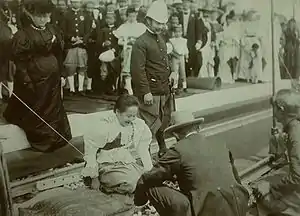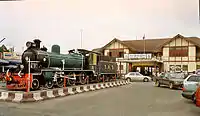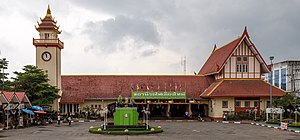History of rail transport in Thailand
The history rail transport in Thailand began with the opening of the Paknam Railway on 11 April 1893.

Previous history
The Kingdom of Siam, the country's name at that time, now known as Thailand. The first Siamese railway projects, which were discussed from the 1840s onwards, were aimed at linking the then British Burma to the Chinese market, which was to be run over Northern Siam for reasons of accessible terrain, a project that had been operating in various variations up to the 1880s, But never realized.[1]:1 A second, early-discussed railway project was to traverse the Isthmus of Kra the narrowest point of the Malay Peninsula with a railway because the Kra Canal was technically unworkable. However, as the British feared the importance of Singapore, this railway was not built even though the Siamese government had agreed in 1859.[1]:1
The King of Siam received a model railway in 1856 as a gift from Queen Victoria, which is now exhibited in the Bangkok National Museum. In 1871 King Chulalongkorn (Rama V), who ruled since 1868, first used railways even during state visits to Java and British India. In 1864, the Dutch colonial administration commissioned the first railroad in Southeast Asia.[1]:2
First projects
In the 1880s, the Siamese government issued various private consortia concessions for the construction of railways. However, these consortia were mostly speculative companies, which never even built their routes. In the end, the first viable railway in Siam, however, emerged from a privately financed initiative: on 11 April 1893, the metre-gauge Bangkok-Samut Prakan route (Paknam) was opened by the king. The king had inaugurated construction in 1891.[1]:8
State rail
Construction of a railway network was initially managed by the Ministry of Foreign Affairs, as the technology and knowledge required was imported from abroad. In 1890, responsibility shifted to the Ministry of Public Works, where the Royal Railway Department (RRD) was created.[1]:2
The government commissioned Sir Andrew Clarke in 1888 to work out plans for a railway network. By 1890 they were complete.[1]:11 In November 1888 the railway engineer de:Karl Bethge (from Krupp) came to Siam and were given these plans by the Siamese government for his assessment. It was agreed to build a route from Bangkok to Saraburi to Korat (Nakhon Ratchasima). The Siamese government called Bethge, engaged in Germany in the Royal Prussian Building Commission, to Thai state service. He became head of the RRD in 1890.[1]:2
Northeast Railway
In 1891, by law, the Nakhon Ratchasima Railway Company, the majority of which was located with the province, was established with the aim of building a railway from Bangkok to Korat in standard gauge (1435 mm). The work was awarded to the English firm, Murray Campbell, contrary to Bethge's advice. After two years of preparation, the construction of the Northeastern Railway was begun on 9 March 1892 by proclamation of King Chulalongkorn. The tools used for the first cut of the spade, a richly ornamented spade and the associated wheelbarrow, are now also exhibited at the Bangkok National Museum. The management of construction was assumed by George Murray Campbell.
Karl Bethge engaged other German engineers for railway construction, Hermann Gehrts (1854-1914) and Luis Weiler (1836-1918), both of the Prussian State Railways. Weiler reported to his father, who was also a railway engineer, in numerous letters. These are almost all preserved and are now in the archives of the Deutsches Museum in Munich.
On 1 September 1896, the railway administration cancelled the contract with the British company, since it did not carry out the construction work in accordance with the contract. The work was now continued on its own initiative. At the same time Nakhon Ratchasima Railway Company was nationalized and converted into a State Railways administration. The completed route was 135 kilometers long at this time. In December 1896, King Chulalongkorn took the opportunity to travel by train to the construction site. On an overhanging rock at 136.5 miles he wrote his name on a rock. The heavily weathered lettering is still visible today. On 26 March 1897 the first section, from Bangkok to Ayutthaya was opened. This date is today the "official birthday" of the State Railway of Thailand. Before the railway opened, a trip between Bangkok and Korat (Nakhon Ratchasima) took five days. By train it was reduced to six hours.
Network expansion

On 24 February 1898, the government adopted the principle that all the main routes in the country should be established as national railways.[1]:4 Karl Bethge died of cholera in 1900, and his successor, Hermann Gehrts, retired in 1904. In the spring of 1904, therefore, Luis Weiler in Haifa, where he was working on the construction of the Hejaz Railway, became the director general of Siamese railways. As he assumed his position, the northeast railway was finished.
 Ensign of the Royal State Railways of Siam in 1898 (Original)
Ensign of the Royal State Railways of Siam in 1898 (Original) Ensign of the Royal State Railways of Siam
Ensign of the Royal State Railways of Siam
German companies such as Henschel and Krupp distinguished themselves in the delivery of locomotives. In 1909 a total of 49 locomotives from Germany went to the Siamese state railway. Other rolling stock was imported from Germany, Belgium, The Netherlands, and United Kingdom.
With the completion of the northeast railway, planning began for the Southern Railway to Phetchaburi. Construction began in April 1900. In contrast to the previously established railway network east of the Chao Phraya River, which was built in standard gauge, the state railway chose metre-gauge, to ease the transition to the also meter-gauge tracks in Burma and Malaya.[1]:40 This made easier as the southern railway was cut off from the rest of the network as there was no bridge across the Chao Phraya River. The southern route therefore did not depart from Bangkok's main railway station, Hua Lamphong Station, but had its own terminus in Thonburi, Thonburi Station. Its station building was designed by the German architect Karl Siegfried Döhring in the style of the Brick Expressionism.
Another project was the Eastern Railway. In 1901 an engineer's survey of the route was commissioned. However, both the southern and eastern railways were complicated by geopolitics: to the south and west of Siam were British colonies and to the east French possessions. The French considered Siamese railway construction, creeping towards French Indochina, as a threat. When, shortly thereafter, a revolt broke out in northern Thailand, the state committed its resources to the construction of the Northern Railway, (Bangkok to Chiang Mai).[1]:34
Northern Railway
The Northern Railway, was not of interest to the European colonial powers. In early-1908, it was completed in Phitsanulok at kilometre 389. On 11 November, the day of the coronation, another 67 kilometres of the northern route were opened. A total of 844 kilometres were then operational in Siam.
Northern Railway gallery
 Phitsanulok station (ca. 1920 by German architect Karl Siegfried Döring).
Phitsanulok station (ca. 1920 by German architect Karl Siegfried Döring). Steam locomotive
Steam locomotive
References
- Whyte, Brendan R (2010). The Railway Atlas of Thailand, Laos and Cambodia. Bangkok: White Lotus Co Ltd. ISBN 9744801573. Retrieved 3 November 2017.
Further reading
- R. Ramaer: The Railways of Thailand. Bangkok: White Lotus Co Ltd, 1994. ISBN 978-974-480-151-7
- กองประชาสัมพันธ์. การรถไฟแห่งประเทศไทย (Public Relation Department, State Railway of Thailand): 100 ปี รถไฟไทย (100 Years of Thai Railway). Bangkok, World Vision Press, BE2540 (1997)
- ปริญญา ชูแก้ว, รักพล สาระนาค, สุรจิต จามรมาน (บรรณาธิการ). 100 ปี สถานีกรุงเทพ (100 Year Bangkok Railway Station), Bangkok BE2559 (2016)
- 110 ปี สถานีรถไฟศาลายา : ประวัติศาสตร์ วรรณกรรม และวัฒนธรรม ว่าด้วยวิวัฒนาการการเดินทางและการขนส่งจากบางกอก-ศาลายา (110 Year Salaya Railway station: History, Literature, and Culture the evolution of travel and transport from Bangkok to Salaya). นครปฐม : ศูนย์สยามทรรศน์ศึกษา คณะศิลปศาสตร์ มหาวิทยาลัยมหิดล (Nakhon Pathom: Center of Thai Studies, Faculty of Liberal Arts, Mahidol University) BE2557 (2014)
